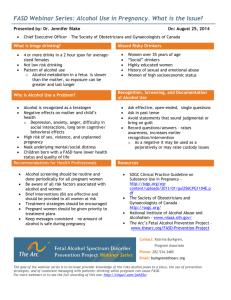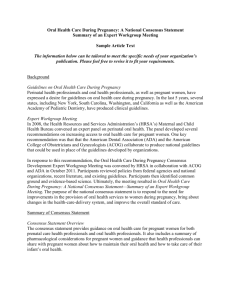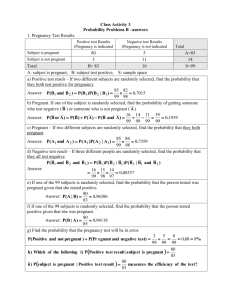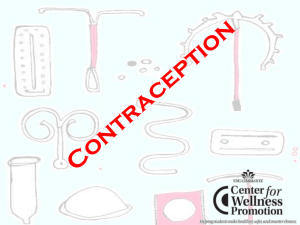Gestoses. Hypertensive diseases in pregnancy. Pre
advertisement
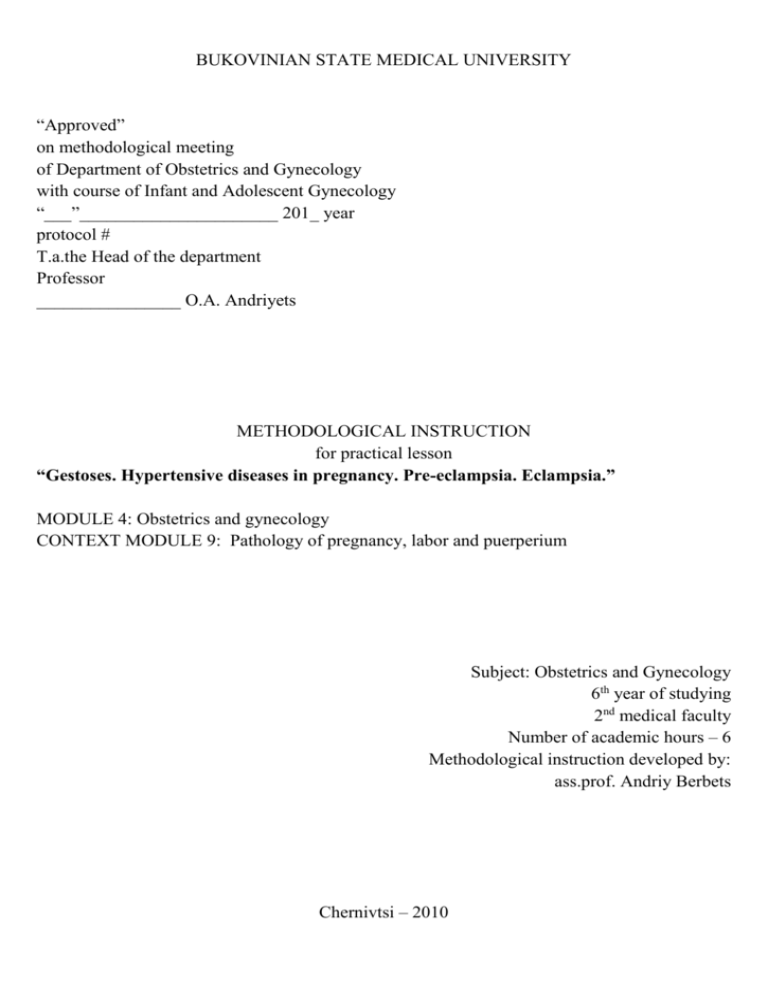
BUKOVINIAN STATE MEDICAL UNIVERSITY “Approved” on methodological meeting of Department of Obstetrics and Gynecology with course of Infant and Adolescent Gynecology “___”______________________ 201_ year protocol # T.a.the Head of the department Professor ________________ O.A. Andriyets METHODOLOGICAL INSTRUCTION for practical lesson “Gestoses. Hypertensive diseases in pregnancy. Pre-eclampsia. Eclampsia.” MODULE 4: Obstetrics and gynecology CONTEXT MODULE 9: Pathology of pregnancy, labor and puerperium Subject: Obstetrics and Gynecology 6th year of studying 2nd medical faculty Number of academic hours – 6 Methodological instruction developed by: ass.prof. Andriy Berbets Chernivtsi – 2010 1. Actuality of theme Early gestosiss is characterized by the variety of clinical symptoms. Some clinical forms (yellow dystrophy of liver, osteomalatio) can threaten to life of patients. Knowing of etiology, pathogeny, feature of clinical motion of gestosiss it is necessary for the doctor of wide type and doctor of more narrow speciality. Actuality of problem conditioned by high-frequency of gestosiss, level of maternal and fetal to morbidity and death rate at late gestosiss, absence of unique point of view on pathogeny, treatment and prophylaxis of this threatening obstetric pathology. Frequency of gestosiss in the last few years does not have a tendency to decreases and makes on the average to 10 % from the number of all births. Moreover, in recent years there is a tendency to the increase of frequency of heavy forms of gestosiss. 2. Duration of class – 6 hour 3. Educational purpose Student must know: 1. Modern view on etiology and pathogeny of gestosiss of pregnant. 2. Classification of early gestosiss. 3. Clinic of early gestosiss. 4. Methods of diagnostics of early gestosiss. 5. Basic principles and methods of treatment of early gestosiss. 6. Prophylaxis of complications and rehabilitation. 7. Classification of late gestosiss. 8. Pathogeny of late gestosiss. 9. Clinic of late gestosiss. 10. Methods of diagnostics of late gestosiss and treatment. Student should be able: 1. To find out the groups of perhaps risk of development of gestosis. 2. To conduct diagnostics of early and late gestosiss. 3. Objectively to estimate complication of gestosis and to own the simple methods of auxiliary inspection. 4. To appoint the additional methods of inspection, interpret them. 5. To be able to work out a plan of individual inspection and treatment. 6. To conduct the prophylaxis of complications and rehabilitation of women with gestosiss. Student must be able to perform the following practical skills: 1. Plan of inspection of pregnant with a gestosis. 2. Give a diagnosis of early and late gestosiss 3. Grant of the first aid at gestosiss. 4. Prescript nosotropic and symptomatic treatment of gestosiss. 4. Base knowledges, abilities, skills, that are necessary for the study (intersubject integration) Name of previous disciplines Got skills Anatomy To describe the anatomic structure of uterus and additions. Physiology To describe physiology processes in a woman organism during births, to give clinical interpretation to reasons of origin of gestosiss, describe the mechanisms of the central and local adjusting of hemodynamics, waterelectrolyte, carbohydrate, fatty exchanges, кислотнолужного state, describe the basic mechanisms of origin of vomit, edemata, hyperpiesis, proteinurea and cramps. Pharmacology To define preparation and to expect a dose for the grant of the first aid and treatment at vomit, hyperpiesis and cramps. 5. Information for the student 5.1. Table of contents of theme Gestosis is the state of expectant mothers, which arises up in connection with development of conceptus or its separate elements and is characterized by the varied symptoms. At the removal of conceptus or its elements of disease is usually halted. After the term of origin and clinical displays the noted states are divided into 2 groups. Disorders which show up in the early terms of pregnancy, more frequent in the first trimester, are named as early gestosis. If clinical symptoms are more shown in ІІ and ІІІ trimesters such conditions are named late gestosis. Gestosis is characterized by disorders and violations of all types of methabolism. Often signs of gestosiss of early term are nausea and vomit of pregnant, ptyalism. Rarer such complications of pregnancy appear as a dermopathy (dermatosis), tetania, cholestasia, sharp fatty dystrophy of liver, tetania of pregnant, horea of pregnant, оsteomalacia, аrtropatia. Modern view on etiology and pathogenic development of gestosis. Simply not certain, it is considered that reasons of origin there can be a few, but a leading role belongs to violations of the functional state of CNS. There are reflex, neurogenic, endocrine, allergic theory. І. Present connection between frequency of vomit of pregnant and biochemical degree of expressed of hyperthyroidism and level of Horionic gonadotropin (HGT). Y-level of HGT swiftly grows in the first trimester and has the maximal value on 10-12 week. The states which the level of HGT grows at, especially strongly (trophoblastic illness multifetation), are associated with heavy early gestosiss of pregnant. At vomit of pregnant mark the temporal coinciding of beginning of vomit with the peak of maintenance of HGT. Low maintenance of HGT is associated with unmaturing anomalies of development. ІІ. It is set that postpartum depression arises up rarer at women which had expressed vomit of pregnant, in comparison with women which did not have early gestosiss. In addition, due to surplus vomit the use pregnant of food stuffs which can be potentially dangerous for her and embryo is warned. It is confirmed, that investigation of pregnancy for a mother and fetus at surplus vomit of pregnant, namely: weight of fetus, term of births, estimation on Аpgar, mortinatality, frequency of anomalies of fetus, does not differ and does not get worse in comparison with general population. But there is intercommunication with possible development of late gestosis and, as a result, by the delay of development of fetus in more late terms. ІІІ. In behalf of allergic theory testify researches at which the considerable increase of level of histamin is discovered in the whey of blood of women with heavy complications of pregnancy (by surplus vomit, eclampsia, unmaturing of pregnancy) in comparison with unpregnant and at normal motion of pregnancy. IV. In pathogeny of vomit of pregnant violation of the neuroendocrine adjusting of all types of exchange is a leading link as a result of partial (or complete) starvation and dehydration, violation of the functional state of CNS. In the early terms of pregnancy the symptoms of early gestosiss (neurosis) show up disorders of function of gastroenteric highway. Food reflexes are the diencefal areas related to the vegetative focis. Going from periphery aferent signals can have wrong character reason of which is the changes in the receptors of uterus or in leading ways, possible changes in the focis of diencefal area, that can change character of reverse eferent impulses. At the broken sensitiveness of the nervous system quickly there are the changes of reflex reactions violation of food functions: loss of appetite, nausea, salivation, vomit. Neuroendocrine and exchanges violations acts considerable part in development of early gestosiss, in connection with what at progress of disease the changes of water-salt, carbohydrate and fatty, and then albuminous metabolism on a background increasing exhaustion and decline of mass of body develop gradually. V. Connection is set between surplus vomit of pregnant and bacteria. The high level of Іg to Helicobacter pylory at patients with early gestosiss when compared to a control group. The maintainance of nausea and vomit in a ІІ trimeter can be as a result of other diseases of GIT or it is related to the presence of Helicobacter pylory. VІ. At research of fetus from women, which suffered heavy early gestosiss, found out expressed pathology of chorion, which was characterized by the decline of invasion activity of cytotrofoblast, absence of intravessel component of the first wave of invasion and presence of uterine arteries with incomplete gestational alteration. The indicated factors explain weight of damage of placenta at early gestosiss as the inferior angiogenesis of atrophy of trofoblast, edema and fibrosis. The found out the changes of uterus-placenta circulation of blood are starting in development of gestosiss which in most pregnant does not show up at first, but act considerable part in development of gestosiss ІІ and ІІІ trimesters. The changes in the organs of pregnant at first have functional character, and afterwards at growth of dehydration, catastatic reactions intoxication by products pass to the dystrophic processes in a liver, buds and other organs. In 55% pregnant with heavy vomitting there are the expressed parafunctions livers, which appear with the help of laboratory tests – coagulogram, hepatic enzymes, that in future can result in serious complications of ІІ halves of pregnancy, in that number to the HELLP-syndrome. The synthesis of albumens and antitoxic function of liver, function of видільна of buds, is violated at first, and then there are the dystrophic changes in CNS, lights, heart. Pathogeny of origin and development of late gestosis. In etiology of this complication act considerable part neurogenic, hormonal, immunological, placentas, genetic factors. The above all links of pathogeny of gestosis are: 1. Spasm of vessels. 2. Hypovolemia. 3. Violation of properties of blood (change of viscidity of blood — haemoconcentration). 4. Development of endothelium disorders, violation of capillary. 5. Metabolic disorders. 6. Syndrome of functional insufficiency. The indicated complex of haemodynamic and metabolic changes is a background on which the dystrophic and haemodynamic changes develop in fabrics vital, stipulating their disfunction. Early gestosis. Naisea. Vomitting. Clinic, diagnostics and prophylaxis of early gestosis. Vomit of pregnant shows itself complication of normal motion of pregnancy and is characterized by the dyspepsia phenomena and violation of all types of exchange. To 12 weeks to pregnancy arises up in 40-60% women. In most cases – poorly expressed, does not require any treatment, appears between 4 and 7 weeks of pregnancy. Classification: - mild vomit of pregnant - moderate vomit of pregnant - severe vomit of pregnant Factors of risk of origin of early gestosiss: - chronic diseases of gastrointestinal tract; - chronic diseases of liver; - dysfunction of thyroid; - young age of pregnant (to 18 years); - trophoblastic diseases in anamnesis; - diabete mellituss; - bronchial asthma. Mild vomiting: - the common state is satisfactory; - frequency is to 4-5 t/d; - periodic (mainly in the morning) nausea; - loss of mass of body less than 5 % initial; - frequency of pulse to 90 in 1’ or normal; - BP within the limits of norm; - absent changes in the clinical blood test; - diuresis is normal. Moderate vomiting: - common state of middle weight; - frequency to 10 t/d; - permanent nausea; - salivation; - easy anaemia; - metabolic acidosis; - violation of water-salt, electrolytic, carbohydrate, lipometabolisms; - decline of diuresis; - dryness of skin; - sometimes reaction of urine on an acetone. Severe vomiting: - the common state is unsatisfactory (rather severe); - frequency of vomit to 20 t/d and more; - permanent nausea; - permanent salivation; - loss of mass of body on more than 10 % initial; - temperature to 38 С; - pulse to 120 bpm - arterial blood pressure is significantly decreased - increased blood level of remaining nitrogen, urea, bilirubine; - increase of haematocrite; - decline of maintenance in the whey of blood of albumens, to potassium, chlorides; - smell of acetone from a mouth, sharply positive reaction of urine on an acetone; - parafunction vital and systems, expressed intoxication and dehydration. For determination of degree of vomit of pregnant next to the clinical inspection it is necessary lead through of the following laboratory invstigations: - the general analysis of blood is determination of haemoglobin, amount of RBC; - coagulograms and haematocrite ; - biochemical blood test is bilirubin, general albumen, albuminous factions, remaining nitrogen, urea, electrolytes (potassium, sodium, chlorides), glucose; - indexes of ground-state; - global analysis of urine – presence of acetone, urobiline, bilious pigents, squirrel; - ultrasonic research of liver, buds, organs of small pelvis, to the embryo for timely diagnostics of trophoblastic illness multifetation. Estimation of severity of vomiting of pregnant Symptom Degree of severity _ Appetite Slightly decreased Considerably Absent decreased Nausea Mild Considerable Permanent, exhausting Ptyalism Slight Considerable Considerable (thick, viscid saliva) Frequency of vomit 3-5 times 6-10 times 11-15 times and more (per day) Frequency of pulse in 80-90 90-100 More than 100 1 min Systolic BP 120-110 110-100 Less than 100 Table of contents of Retains Partly Does not retain meal Body weight loss 1-3 kg (to 5% from 3-5 kg (1 kg in a More than 5 kg (2-3 initial mass) week, 6-10% from kg in a week, more initial mass) than 10% from initial mass) Dizziness Rarely In 30-40% patients, it In 50-60% patients, it is moderato is considerably expressed expressed Increases of Absent Rarely In 35-60% patients temperature Icteric of scleroticas It is not In 5-7% patients In 20-30% patients and skin Hyperbilirubinemia It is not 21-40 21-60 Dryness of skin + ++ +++ Diuresis 900-800 ml 800-700 ml Less than 700 ml Acetonuria It is not Periodically in 20- IN 70-100% 50% Ptyalism. Increase of secretion in the cavity of mouth of pregnant. On occasion day's ptyalism achieves one litre and anymore. A considerable sialosis results in the decline of albumens, vitamins, salts of sick. Treatment. Mild vomiting of pregnant responds to treatment or passes independently. Vomit can independently pass in spite of the fact that, to pregnant with easy vomit it is also needed to appoint therapy which includes recommendations on the mode of day and diet. Treatment of pregnant with easy vomit it is possible to conduct ambulatory. At the moderate expressed and severe vomit the active treatment in required. Basic components of therapy: - diet; in connection with the decline of appetite the varied meal which must be useful is recommended, to contain plenty of vitamins; a meal must be adopted by small portions each 2-3 hour in a frappe' kind and in position lying; reception of mineral alkaline water rotined also in small volumes 5-6 time per a day; it is better to halt application of preparations of iron to stopping of nausea; before to get up from a bed, to eat dry bread or thin captain; to drink tea with a mint; to limit the reception of products with high maintenance of fats and albumens; - treatment is the removal of negative emotions, establishment of favourable psychological microclimate, protracted sleep isolation of pregnant from pregnant with similar symptoms; - electroanalgesia, hypnotherapy, that is sufficient for treatment of easy vomit, and at moderate and surplus vomit they allow to decrease the medicinal loading on the organism of pregnant. Complex therapy of vomit of pregnant includes: - influence on CNS, blocking of vomit reflex; - normalization of endocrine and exchanges violations, vitamin; - normalizations of water-electrolyte balance parenterally feed; - antihistaminics; Treatments continue to disappearance of symptoms. By the basic rule of medicinal therapy at heavy and middle degrees of weight of vomit there is the parenterally method of conduct during 5-7 of virgins (or to achievement of proof effect). For the treatment of dehydration of organism therapy in an amount 1,0-2,5 l/d depending on the degree of weight of early gestosiss and mass of body of pregnant. The following preparations are entered: isotopic solution of chloride of sodium, glutargin, berlition, solution of albumen. Complex therapy is continued to the proof stopping of vomit, normalization of the common state gradual increase of mass of body; extract in 5-7 days after stopping of vomit. Prognosis. 1. At easy vomit of pregnant favourable; easily responds to treatment or passes independently; in 1015% can pass pregnant to the next stage. 2. At the moderato expressed vomit prognosis favourable, but the pregnant needs setting of holiatry. 3. At surplus vomit prognosis often bad ; at appearance of threatening symptoms break pregnancy. Classification of late gestosiss of pregnant. Clinic and diagnostics. Modern methods of treatment of late gestosis. Liquid forms of gestosiss. By association of obstetricians-gynecologists of Ukraine (1998) it is recommended and ratified the following classification of gestosiss: 1. Hypertension during pregnancy. 2. Edemas during pregnancy. 3. Proteinuria during pregnancy. 4. Preeclampsia of mild degree. 5. Preeclampsia of moderate degree. 6. Preeclampsia of severe degree. 7. Еclampsia. Classification of hypertension disorders at pregnancy Chronic hypertension is hypertension, that was observed to pregnancy or appeared (first discovered) before 20 weeks to pregnancy. Gestational hypertension is hypertension, that arose up after 20 weeks of pregnancy and is not accompanied by proteinuria up to birth. Тransitory gestational hypertension is normalization of BP in women, which carried gestational hypertension, during 12 weeks after birth (retrospective diagnosis). Chronic gestational hypertension is hypertension, that arose up after 20 weeks of pregnancy and is saved in 12 weeks after births. Preeclampsia is hypertension, that arose up after 20 weeks of pregnancy in combination with proteinuria (table of contents of albumen 0,3 g/l in middle portion to the urine collected twice with an interval 4 hour or anymore). Eclampsia Preeclampsia is united is appearance of proteinuria after 20 weeks of pregnancy on a background chronic hypertension. Hypertension not is specified is hypertension discovered after 20 weeks of pregnancy on condition of null information in relation to arterial blood pressure to 20 weeks to pregnancy. The such special forms of late gestosis did not enter before this classification, as НЕLLР-syndrome and acute fat hepatosis, on condition of development of which the risk for fetus and pregnant is extremely ever-higher, that needs immediate adequate actions. Diagnostics, treatment and obstetric tactic, in the case of these forms of gestosis concerne by separate protocols. Diagnostics Diagnostic criteria of preeclampsia Diagnosis dyastolic Proteinuria, Other signs АТ, mmHg g/d Mild preeclampsia 90-99 <0,3 — Preeclampsia of moderate 100-109 degree Severe preeclampsia 110 0,3-5,0 Eclampsia More 0,3 More 90 >5 Edemata on face, hands, sometimes head pain Edemata, considerable, head pain, paropsis, pain, in an epigastrium, hyperreflexia, оliguria (< 500 ml/d), trombocytopenia Seizures or convulsions (at least one episode) Mild preeclampsia. The grant of help depends on the state of pregnant, parameters of АP and proteinuria. In the case of accordance of the state of pregnant to the criteria of easy preeclampsia at the term of pregnancy to 37 weeks possible supervision in the conditions of permanent establishment of daily stay. Determine the term of pregnancy. Conduct the studies of patient to the independent monitoring of basic indexes of development of preeclampsia: measuring of АP, control of balance of liquid and edemata, registration of motions of fetus. Additional laboratory criteria of preeclampsia Signs Mild Preeclampsia of Severe preeclampsia moderate degree preeclampsia Urinary acid, mmol/l <0,35 0,35-0,45 >0,45 Urea, mmol/l Kreatinine, mkmol/l Thrombocytes -109l <4,5 <75 > 150 4,5-8,0 75-120 80-150 >8 > 120 or оliguria <80 The laboratory investigation to be conducted: global analysis of urine, day's proteinuria, kreatinine and urea of plasma of blood, haemoglobin, haematocrit, amount of thrombocytes, coagulogram, АlАТ and АsАТ, determination of the state of fetus (unstressing test for possibilities). Medicinal therapy is not needed. The use of liquid and salt is not limited. Preeclampsia of moderate degree. Hospitalization. At the term of pregnancy 37 weeks and anymore is the planned hospitalization of pregnant to permanent establishment of the II level for labor. At the term of pregnancy less than 37 weeks, progress of preeclampsia or violation of the state of fetus is hospitalization of pregnant to permanent establishment of the IIІ level. Primary laboratory inspection: global analysis of blood, haematocrit , amount of thrombocytes, coagulogram, АlАТ and АsАТ, blood type and rhesus factor (in the case of absence of exact information), global analysis of urine, determinations of day's proteinuria , kreatinine, urea, urinary acid of plasma, electrolytes (sodium and potassium), estimation of the state of fetus. Protective mode is limitationуed of the physical and psychical loading. Rational feed: meal with enhanceable maintenance of albumens, without limitation of salt and water, use of products which do not cause thirst. Complex of vitamins and oligoelementss for pregnant, at the necessity of - iron. When dyastolic AP is 100 mmHg prescribe hypotensions preparations (metildofa for 0,25-0,5 g 3-4 times per days, maximal dose - 3 g on days; at a necessity add nifedipin for 10 mg 2-3 times per days, maximal day's dose-100 of mg) . At the term of pregnancy to 34 weeks appoint dexametason for 6 mg in 12 hour four times during 2 days. for the prophylaxis of respirator distress -syndrome. Dynamic supervision: - the control of АP is every 6 o'clock of the first days, in future - twice on days; - control state of fetus is every 8 hours; - day's proteinuria - every day; - haemoglobin, haematocrit , coagulogram, amount of thrombocytes, АlАТ and АsАТ, kreatinine, urea, is every three days; - monitoring of the state of fetus: amount of motions for 1 hour, frequency of heart-beaten - daily; - estimation of biophysical type of fetus (after testimonies); At progress of preeclampsia or worsening of the state of fetus begin preparation to labor: - preparation of maternity ways in the case of «immature» neck of uterus – Pr Е. Labor. The method of labor in any term of pregnancy concernes by readiness of maternity ways or state of плода. Severe preeclampsia Primary laboratory inspection: global analysis of blood, haematocrit, amount of thrombocytes, coagulogram, АlАТ and АsАТ; blood type and rhesus factor (in default of); global analysis of urine, determination of proteinuria, kreatinine, urea, general albumen, bilirubin and his factions electrolytes. Careful dynamic supervision: - control of АТ - hourly; - heart beaten of fetus is every 15 minutes; - the uranalysis is every 4 hours; - control of diuresis every hour (cannulation of urinary bladder by the catheter of Falea); - haemoglobin, haematocrit , amount of thrombocytes, functional hepatic tests kreatinine of plasma - every day; - monitoring of the state of fetus: amount of motions for 1 hour, frequency of heart-beaten - daily, for possibilities is US control of circulation of blood in the vessels of umbilical cord, vessels of brain of fetus, placenta and fetoplacental complex; - estimation of volume of amnion waters and biophysical type of fetus - after testimonies; - test on absence of stress of fetus - at worsening of indexes of the daily monitoring of fetus and necessarily before labor. Treatment. Protective mode (severe bedly) exception of physical and psychical tension. Complex of vitamins for pregnant, at a necessity are oligoelementss. At the term of pregnancy to 34 weeks are dexametasone for 6 mg in 12 hour four times during 2 days. In the case of necessity conduct preparation of maternity ways by Pr E. Tactic of conduct active with labor at nearest 24 o'clock from the moment of establishment of diagnosis. Treatment of hyperpiesis is not nosotropic, but necessity for a mother and fetus. Decline of АP has for an object of warning of cerebral hemorrhages. It follows to aim to take АТ to the safe level (150/90-160/100 mm item, not below!). Hypotensive therapy is conducted at the increase of dyastolic pressure together with maghesial therapy. Labetalol is applied at first intravenously 10 mg in 10 minutes, in default of adequate reaction (remained dyastolic АP higher 110 mmHg) - additionally a 20 mg preparation. АP controls every 10 minutes, and if dyastolic pressure there is higher 110, enter 40 mg, and then 80 of mg лабеталолу (maximally to 300 mg). In default of labetalol possible application of nifedipin 5-10 mg under a language. If an effect is absent, in 10 minutes it is necessary to give a 5 mg preparation under a language. For the decline of АТ at heavy прееклампсії applies hydralasine also: to a 20 mg (1 ml) preparation dissolve a 0,9% solution of chloride of sodium in 20 ml, enter slowly intravenously for 5 ml (5 mg) every 10 minutes, while dyastolic АТ will not go down to the safe level (90-100). At a necessity repeat intravenous introduction of hydralasin for 5-10 mg hourly or 12,5mg intramuscular every 2 hours. Metildofa for treatment of heavy preeclampsia applies rarer, as preparation has the deferred action (an effect comes in 4 hours). As a rule, apply doses 1,0-3,0 g on days as monotherapy or in combination with nifedipin 0,5 mg/kg/d. Magnesia therapy is introduction 4 g dry matters of sulfate of magnesium with subsequent continuous intravenous introduction with speed which concernes by the state of sick. Magnesia therapy is begun from the moment of hospitalization, if dyastolic АP > 130 mmHg Starting dose – 4 mg dry matter (16 ml 25%th solution of sulfate of magnesium) enter by a syringe very slowly during 15 minutes (in the case of eclampsia - during 5 minutes). Because of that the concentrated solution of sulfate of magnesium can cause the considerable irritation of wall of vein introduction (up to necrosis) is conducted in which, the starting dose of sulfate of magnesium is dissolved in a 0,9% solution of chloride of sodium. For this purpose in a sterile small bottle from 34 ml solutions enter to 4 g magnesiums of sulfate (16 мл 25%th solution). Supporting therapy standard begin with the dose of a 1 g dry matter of sulfate of magnesium on a hour. At such speed of introduction the concentration of magnesium in the whey of blood will attain 4-8 mmol/l (therapeutic concentration) in 18 hours. At introduction with speed 2 g/h - in 8 hours, and at speed 3 g/h. - after 2 hours. Common amount of liquid, that is entered, is made from 75 to 125 ml in a hour and not must exceed 2500-3000 ml for days (35 ml/kg) (taking into account a liquid, that is entered with the sulfate of magnesium, and at the taken a swig liquid). The signs of magnesium intoxication are possible even on a background the therapeutic concentrations of magnesium in plasma of blood on condition of combination with other preparations. With appearance of signs of toxicness of sulfate of magnesium appoint to a 1 g calcium (10 ml 10%th solution) of i/v, which always must be bedside sick. Monitoring of the state of pregnant: - measuring of АP each 20 min; - count of pulse; - supervision after frequency and breathing character (FB must be not less than 14 after 1 min.); - control heart beaten of fetus; - verification of knee-jerks each 2hour; - control of diuresis every hour (it must be not less than 50 ml/hour.). In addition, control: - symptoms of growth of weight of preeclampsia: head pain, paropsis (doubling of objects, «twinkling of beauty-spot» in eyes), pain, in an epigastrium; - symptoms of possible edema of lights: weight in breasts, cough, stuffiness, increase of ЦВТ, appearance of crepitus or moist wheezes, growth of pulse and decline of level of consciousness; - state of fetus. Conduct magnesia therapy during 24-48 hours after births, together with symptomatic treatment. It should be remembered that application of sulfate of magnesium during births and in an early puerperium reduces retractive activity of uterus. next pregnancy. Eclampsia. About the high risk of eclampsia testify: severe headache, high hypertension (dyastolic АТ > 120 mmHg), nausea, vomits, paropsis, pain. Primary objectives of urgent help: - stopping of cramps; - renewal of communicating of respiratory tracts. Tasks of intensive therapy after sessation of cramps: - warning of the repeated convulsive attacks; - removal of hypoxia; - prophylaxis of aspiration syndrome; - exigent labor. First aid at development of attack of eclampsia. Treatment in the case of attack of cramps begins in place. Open out the chamber of intensive therapy or hospitalize pregnant to the separation of intensive therapy. Sick conclude on an even surface in position on left, quickly free respiratory tracts, opening a mouth and pulling out a lower jaw ahead, parallell will evacuate maintenance of mouth cavity. For possibilities, if the spontaneous breathing is stored, enter tube and conduct inhalation of oxygen. Parallell with the conducted measures on renewal of adequate interchange of gases carry out the cannulation of peripheral vein and begin introduction of anticonvulsant preparations (sulfate of magnesium is bolus 4 g during 5 minutes intravenously, then supporting therapy 1-2 g/hour) under the careful control of АP and pulse. If the attacks last, intravenously enter to 2 g sulfates of magnesium (8 ml a 25% solution) during 3-5 minutes. In place of sulfate of magnesium additional to the bolus it is possible to use diasepam intravenously (10 mg) whether tiopental-sodium (450-500 mg ) during 3 minutes. If the attack of cramps lasts above ЗО of minutes, examine this state as eclampsia status If dyastolic АP remains at high level (> and 10 mmHg), conduct hypotensive therapy. All manipulations (cannulation of veins, urinary bladder, obstetric manipulations) conduct under general anaesthesia by тіопенталом-sodium or nitrous oxide with oxygen. After liquidation of cramps conduct the correction of metabolic violations, water-electrolyte balance and ground-state, proteometabolism. The inspections carry out after stopping of attack of cramps. Consultation of neurologist and oculist. Labor is carried out quickly. Liquid forms of gestosiss. 1. Dermatosis of pregnant: dominant sign there is the itch of skin. 2. Fatty dystrophy of liver: as a result of intoxication there is the fatty and albuminous regeneration of cages of liver. Sharp fatty dystrophy of liver is the absolute show to breaking of pregnancy. 3. HELPP-syndrome — this (Н) – hemolytic anaemia, elivated liver ferments is enhanceable concentration of enzymes of liver in plasma of blood; Low piatelet (LP) decline of level of thrombocytes. Thus a maternal death rate achieves 3,5%, and fetus — 79%. The physiopathologies changes at a HELLP-syndrome take place mainly in a liver. Role of female dispensary in the prophylaxis of gestoses 1. Selection of expectant mothers which belong to the group of risk. 2. Planning of pregnancy to the women with the risk of development of gestosiss : it costs to recommend the terms of conception so that development of pregnancy was on summer-autumn periods. 3. Clinical supervision after pregnant by the gynaecologist and another types specialists. 4. Removal of negative emotions in the way of life and on production. 5. 5.2. Theoretical questions 1. What modern looks on etiology and pathogeny of gestosiss of pregnant? 2. What diseases worsen motion of gestosiss? 3. What are classifications of gestosiss of pregnant (with the list of forms and degrees of weight of disease)? 4. What is clinic of that vomits of pregnant? 5. What are basic principles of treatment of that vomits pregnant and preparations which are used for this pathology? 6. What testimonies for ahead of shedule breaking of pregnancy at gestosiss? 7. What do you know the liquid forms of gestosiss? 8. What are methods of diagnostics of late gestosiss? 9. What are first aid and treatment of late gestosiss? 10. What measures on the prophylaxis of gestosiss of pregnant? 5.3 Practical works (task) which are executed 1. To work out a plan of inspection of pregnant with early and late gestosiss, depending on the degree of weight. 2. To appoint treatment of gestosiss. 3. To give urgent help at the heavy forms of gestosiss. 4. To conduct differential diagnostics between gestosiss and diseases of gastroenteric diseases, heard system diseases, CNS, pochard. 5.4.Self-control materials А. Question for self-control: 1. What modern looks on etiology of origin of gestosiss of pregnant? 2. What diseases can entail or strengthen motion of gestosiss? 3. What is based on classification of gestosiss of pregnant? 4. What nosotropic features of origin of that vomits of pregnant, appearance of edemata, increase of arteriotony, appearance of cramps? 5. What basic principles of treatment of gestosiss pregnant and preparations which are used for the noted pathology? 6. What testimonies for ahead of shedule breaking of pregnancy at gestosiss? 7. What measures on the prophylaxis of gestosiss of pregnant? B. Tasks for self-control: 1.Pregnant H. delivered by the first-aid by complaints about great pain in the area of stomach, vomits, head pain twinkling of beauty-spot before eyes. Week ago, in connection with preeclampsia of easy degree, offered hospitalization, but the sick renounced. Objectively: a skin is pale, edemata on shins and feet, АP - 160/90 160/100 mmHg Uranalysis: albumen - 4 g/l. What is reliable diagnosis? A. Preeclampsia middle degree B. Food intoxication C. Preeclampsia heavy degree D. Nephritis E. Sharp pancreatitis 2.Pregnant of in a term 35 weeks, state heavy. Grumbles about head pain, paropsis, blinking of “beauty-spot”, before eyes, edema , АP is 180/120 mm, tonic cramps appeared suddenly. Breathing was halted. In 1 minute of breathing recommenced. Amnesia. In the clinical uranalysis: albumen 7 g/l. What is reliable diagnosis? A. Eclampsia B. Craniocerebral trauma C. Hypertensive crease D. Preeclampsia heavy degree E. Epilepsy 3. At pregnant in a term 37 weeks there are the edemata, АТ 170/120 mm Hg, proteinuria 4 g/l. Syndrome of delay of development of fetus. What pathology stipulated such complication? А.Eclampsia В.Preeclampsia heavy degree С. Hypertensive crease D.Preeclampsia middle degree Е.Preeclampsia easy degree В.Test 1. Diseases which do not assist to development of preeclampsia heavy degree: A. Chronic nephritis B. Saccharine diabetes C. Hypertensive illness D. Twice pregnancy E. Placenta privies 2. About weight of gestosiss of early terms of pregnancy testify all resulted symptoms, except for: A. Degrowth body B. Edemata C. Presence of acetone in urine D. Blood pressures low E. Increases temperatures 3. Gestational hypertensia is the increase of arteriotony after: A. 20 weeks pregnancies In. 15 weeks pregnancies С. 10 weeks pregnancies D. 5 weeks pregnancies E. Implantations 4. The diagnosis of proteinuria is proposed at presence of in urine: A. Protein 0,3 g/l in middle portion to the urine collected twice with an interval 4 hour В. Protein 0,003g/l С. Protein 0,3 g/l in middle portion of urine D. Non-permanent increase of protein E. Protein 0,1 g/l in middle portion to the urine collected twice with an interval 4 hour 5. Preeclampsia is : A. Appearance of edemata В. Gestation hypertension in combination with proteinuria С. Increases arteriotony D. Appearance of edemata and proteinuria E. Proteinuria 6. To the early gestosiss belong: A. Vomit of pregnant В. Proteinuria С. Hypertensia D. Preeclampsia E. Eclampsia 7. Early gestosiss usually last to: A. 5 weeks pregnancies B. 12 weeks pregnancies С. 20 weeks pregnancies D. 8 weeks pregnancies E. 22 weeks of pregnancy 8. At early gestosiss is observed A. Delay of liquid В. Loss of liquid С. Loss of albumens with urine D. Increase of arteriotony E. Decline of temperature of body 9. Preparations of choice for treatment of heavy preeclampsia A. Sulfate of magnesium В. Natrium С. Calcium D. Noshpa E. Kaptopress 10. General volume of liquid, that is entered for treatment of heavy preeclampsia must make: A. 10 ml/kg In. 5 ml/kg С. 30-35 ml/kg D. 20 ml/kg E. 100 ml/kg Literature Basic 1. Бодяжина В.И. Акушерство / В.И.Бодяжина, К.Н.Жмакин, А.П. Кирющенков - М., 1998. -С. 107-113. 2. Запорожан В.М. Акушерство і гінекологія / В.М.Запорожан - К: "Здоров'я", 2000. - С. 172-177. 3. Айламазян Е.К. Акушерство : Учебник для медицинских вузов / Е.К.Айламазян - С-Петербург, 2007 – 528 С. 4. Про затвердження клінічних протоколів з акушерства та гінекологічної допомоги / МОЗ України – Наказ № 676, 31.12.2004 р.– К. : МОЗ України, 2004 – 166 С. Additional 1. Справочник по акушерству и гинекологии / [Г.К.Степанковская, Л.В.Тимошенко, Е.Т. Михайленко и др.]; под ред. Г.К. Стспанковской. - К.: Здоров'я, 1997. - С.187-190 2. Дуда И.В. Клиническое акушерство / И.В. Дуда, В.И.Дуда. - Минск, 1997. - С. 80-92. 3. Степанківська Г. К. Акушерство / С. Г. К.тепанківська, Є.Т. Михайленко. — К., 2000. 4. Венцкивский Б. М. Поздние гестозы беременных : Неотложные состояния в акушерстве / В Б. Менцкивский, А.А.Ходак. — К : Здоров’я, 2000. — с. 155—190, 6. Кутаров В.Н. Гестоз: патогенез, симптоматика, лечение / В.Н.Кутаров, В.А.Линда. — СПб : Гипократ, 2000. — 160 с.

